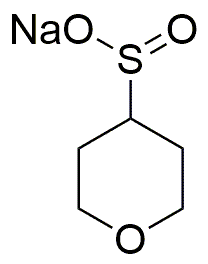Sodium tetrahydropyransulfinate is widely utilized in research focused on:
- Organic Synthesis: This compound serves as a versatile reagent in organic chemistry, facilitating the synthesis of various sulfinate esters, which are important intermediates in the production of pharmaceuticals and agrochemicals.
- Analytical Chemistry: It is employed in analytical methods for the detection and quantification of sulfinate compounds, aiding researchers in quality control and environmental monitoring.
- Pharmaceutical Development: The compound plays a role in drug formulation, particularly in enhancing the solubility and stability of active pharmaceutical ingredients, which can lead to more effective medications.
- Material Science: Sodium tetrahydropyransulfinate is used in the development of new materials, such as polymers and coatings, that require specific chemical properties for improved performance and durability.
- Biochemical Applications: It is utilized in biochemical assays and research, particularly in studying sulfinate-related metabolic pathways, which can provide insights into various biological processes and disease mechanisms.
General Information
Properties
Safety and Regulations
Applications
Sodium tetrahydropyransulfinate is widely utilized in research focused on:
- Organic Synthesis: This compound serves as a versatile reagent in organic chemistry, facilitating the synthesis of various sulfinate esters, which are important intermediates in the production of pharmaceuticals and agrochemicals.
- Analytical Chemistry: It is employed in analytical methods for the detection and quantification of sulfinate compounds, aiding researchers in quality control and environmental monitoring.
- Pharmaceutical Development: The compound plays a role in drug formulation, particularly in enhancing the solubility and stability of active pharmaceutical ingredients, which can lead to more effective medications.
- Material Science: Sodium tetrahydropyransulfinate is used in the development of new materials, such as polymers and coatings, that require specific chemical properties for improved performance and durability.
- Biochemical Applications: It is utilized in biochemical assays and research, particularly in studying sulfinate-related metabolic pathways, which can provide insights into various biological processes and disease mechanisms.
Documents
Safety Data Sheets (SDS)
The SDS provides comprehensive safety information on handling, storage, and disposal of the product.
Product Specification (PS)
The PS provides a comprehensive breakdown of the product’s properties, including chemical composition, physical state, purity, and storage requirements. It also details acceptable quality ranges and the product's intended applications.
Certificates of Analysis (COA)
Search for Certificates of Analysis (COA) by entering the products Lot Number. Lot and Batch Numbers can be found on a product’s label following the words ‘Lot’ or ‘Batch’.
Numéro de catalogue
Numéro de lot/série
Certificates Of Origin (COO)
This COO confirms the country where the product was manufactured, and also details the materials and components used in it and whether it is derived from natural, synthetic, or other specific sources. This certificate may be required for customs, trade, and regulatory compliance.
Numéro de catalogue
Numéro de lot/série
Safety Data Sheets (SDS)
The SDS provides comprehensive safety information on handling, storage, and disposal of the product.
DownloadProduct Specification (PS)
The PS provides a comprehensive breakdown of the product’s properties, including chemical composition, physical state, purity, and storage requirements. It also details acceptable quality ranges and the product's intended applications.
DownloadCertificates of Analysis (COA)
Search for Certificates of Analysis (COA) by entering the products Lot Number. Lot and Batch Numbers can be found on a product’s label following the words ‘Lot’ or ‘Batch’.
Numéro de catalogue
Numéro de lot/série
Certificates Of Origin (COO)
This COO confirms the country where the product was manufactured, and also details the materials and components used in it and whether it is derived from natural, synthetic, or other specific sources. This certificate may be required for customs, trade, and regulatory compliance.


